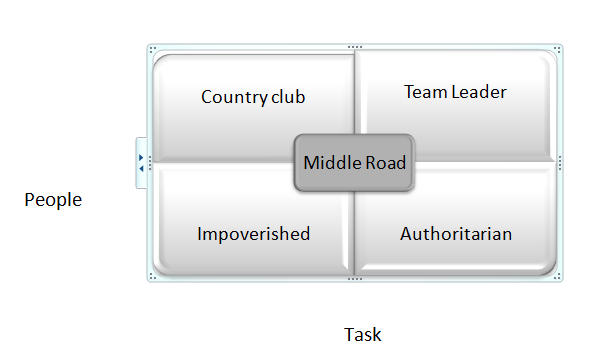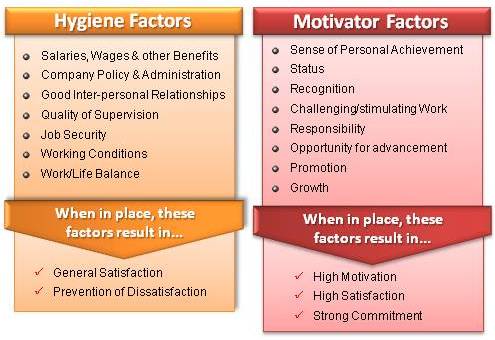Management

Employee motivation can be defined as “influencing others in a specific way towards goals specifically stated by the motivator, conforming within organisational constraints” (MacKay, 2007, p.21) and the level of motivation of the workforce represents one of the most critical factors affecting organisational performance. One of the main reasons for increasing importance of motivation in the workplace relates to the role of human resources becoming greater in ensuring long-term growth for the business. Employee motivation is an essential component of a successful business practice. No matter how appealing products and services a company is providing, how efficient are company’s business and marketing strategy and what size of budget does a company have to operate, low morale and lack of motivation in employees could be a major problem for companies who aim to make a profit in marketplace. It has been argued that while each individual has a general idea of what motivation is, these ideas differ from each other. One of the most comprehensive definitions of the term motivation is offered by Business Dictionary (2012) as internal and external factors that stimulate desire and energy in individuals to be interested and committed to a position, role or subject in a continuous manner, and exhibit persistent effort in achieving a goal. Alternatively, motivation can be defined as “a process of stimulating someone to adopt a desired course of action” (Kumar, 2008, p.12), and the level of employee motivation can be justly specified as one of the major factors contributing to overall organisational competitiveness It has been also said that “all employees have unique needs that they seek to fulfil through their jobs. Organisations must devise a wide array of incentives to ensure that a broad spectrum of employee needs can be addressed in the work environment, thus increasing the likelihood of…

Being updated with the relevant legislations is the main responsibility of organisational managers in dealing with the legal aspects of firm’s information system. Moreover, major legal areas of information systems to be addressed by managers include Data Protection Act(1998), appropriate dealings with intellectual properties, abiding to relevant contractual obligations and safeguarding the firm from breaching relevant criminal and civil laws. Main legal requirements of dealing with information in UK are specified in Data Protection Act (1998) and these are formulated through eight main principles. Neglecting or abusing these principles can result in civil or criminal charges for firms involved. The present age of information is causing the importance of management information systems to increase at a rapid pace and this tendency is expected to continue in the foreseeable future. Moreover, today firms have an opportunity of increasing the level of their competitiveness through increasing the level of information systems in decision making at strategic and operational levels. However, there is a set of important security, ethical and legal implications of management information systems discussed in this paper that should not be neglected by organisational managers. Neglecting or abusing these security, ethical and legal aspects of information systems can result in highly negative implications for the company such as damage to the brand image, loss of customer loyalty, or even civil or criminal prosecution in some instances.

It is important to distinguish between ethical and legal implications of information system management in a way that unlike legal issues, ethical issues do not necessarily result in the organisations being punished by law; nevertheless, unethical behaviour can have highly negative implications for the society. Ethical implications of information system management cover a wide range of issues such as disclosure of information to third parties, accuracy of information, information ownership issues, appropriate access to information and others. Moreover, increasing popularity of social networking sites such as Facebook, Twitter and YouTube in the global scale are proving to be another source of information system management ethical issues. Specifically, “a number of information system companies have sprung up to provide products designed to monitor social media” (Stair and Reynolds, 2011, p.30) and this practice is attracting criticism from various parties for being contradictory form ethical viewpoint. Critics argue that information posted in social networking sites are private and firms do not possess ethical rights to use this information for marketing and other purposes. References Stair, R & Reynolds, G. (2011) “Principles of Information Systems” Cengage Learning

Widely considered as a controversial genius and a charismatic leader, Steve Jobs has served as chairman and CEO of Apple for 14 years and he is credited for the global success of the company. The decease of Steve Jobs on October 5, 2011 because of cancer implications resulted in grievances for millions of people around the globe, at the same time casting concerns for the future of Apple Inc. Although, a long-term Apple executive with impressive track record – Tim Cook has been named apple CEO several months before the decease of Steve Jobs, nevertheless, there are concerns about the sustainability of Apple’s innovative corporate culture, as this culture had been closely associated with the former CEO. Apple Organisational Culture on Steve Jobs Era Late Apple chairman and CEO, Steve Jobs is widely perceived as unconventional leader who was able to rally various stakeholders of the company for his vision and at the same time “demanded excellence from his staff and was known for his blunt delivery of criticism” (McInerney, 2011). According to Harrison’s Model of Culture (1972) Apple organisational culture when Steve Jobs was in charge can be classified as a power culture. Accordingly, Steve Jobs had concentrated most of the decision making powers at his hands, constantly challenging subordinates for better performance, and criticising employees blatantly and undiplomatically if their performances did not meet his expectations (Arneson, 2011). Moreover, described as “antithesis of servant leadership model” (Katzenbach, 2012), Steve Jobs was famous for pressurising teams and individuals to better performance and creating a corporate culture of high level of performance where A list employees would thrive, however B list employees, comprising the majority of workforce, would be subjected to unnecessary level of stress. According to Harrison’s Model of Culture (1972) the power culture has both advantages, as well…

Information can be specified as a compulsory element to be used in decision making in organisations. Decisions taken in organisations can be divided into two categories – strategic and operational, and each type of decision is associated with relevant information needs. Specifically, decision making at a strategic level addresses issues that have long-term implications for the performance of the whole organisation in general. For example policy formulation, new market development, new product development, or decisions related to corporate social responsibility issues can be mentioned as instances for strategic decision making. The type of information needed for strategic decision making may include market share, tendencies in global marketplace, consumer preferences, proposed changes in relevant legislation etc. Operational decision making, on the other hand, relate to the type of decisions relating to daily operations that have implications to a particular department, not necessarily the whole organisation. Information needs for operational decision making may relate to regional sales data, supply-chain management for a specific product, or any other similar information. Critical success factors (CSF) can be defined as “the limited number of areas in which satisfactory results will ensure successful competitive performance for the individual, department, or organisation” (Mard et al., 2004, p.114) and CSF can prove to be instrumental in determining organisational need for information. The nature of CSF for any given organisation depends on a range of factors such as the type of industry, the level of competition, the source of competitive advantage for the firm etc. For example, a CSF for a fast-food restaurant can be specified as reducing the duration of time a customer waits for his food without compromising the quality of the food. Accordingly, key decisions (KD) directly related to CSF for this specific business can be specified as deciding what goes into the menu of the…

Managerial Grid introduced by Blake and Mouton (1964) classifies management practices according to the level of managers’ concern for people and concern for production. Specifically, the Managerial Grid specifies four types of managers: impoverished, authority obedience (produce or perish), country club, and team leader. According to the grid impoverished management characterises a type of management style where the manager has low level of concern for both, employees and task. Impoverished managers with low concern for people and production are the least desired type of managers in terms of achieving organisational objectives. Cases where managers focus on task with a low level of concern to people would relate to authoritarian management style. There is also an alternative management style known as a ‘country club’ where manager focuses on the quality of relationships with employees to an extent that the quality of work can be compromised. “This kind of manager would concentrate efforts on the establishment of a pleasant workplace with friendly and comfortable human relations” (Miller, 2011, p.49). Authority obedience (produce or perish) management prioritises production, but has low concern for employees. In such environments all components of production are achieve maximum input from employees. With high concern for people, as well as, for production, team leaders are best positioned to achieve organisational objectives in an efficient manner (Mumford, 2009). Moreover, as it can be seen from the figure above, some managers position themselves in ‘middle of the road’ trying to balance various management roles within the Managerial Grid. According to Blake and Mouton managers need to strive for team leader position within the grid so that positive results can be achieved with fewer efforts. References Miller, K. (2011) “Organisational Communication: Approaches and Processes” Cengage Learning Mumford, M.D. (2009) “Leadership 101” Springer Publishing Company Murphy, D.J. & Willmott, H. (2010) “Organisation…

Thomas (2009) offers a comprehensive analysis of issues associated with intrinsic motivation at work. The author argues that “intrinsic rewards come to workers directly from the work they do – satisfactions like pride of workmanship or the sense that they are really helping customers” (Thomas, 2009, p.13). Three C’s of intrinsic motivation have been identified by Kohn (1993) as collaboration, content and choice. Specifically, according to Kohn (1993), collaboration involves creating an atmosphere where employees can cooperate with each-other as team members, whereas, content relates to understating the manner in which any specific job adds value and contributes to the achievement of organisational objectives. Choice element of intrinsic motivation, on the other hand, involves providing greater freedom and autonomy to employees in terms of dealing with their responsibilities, and increasing the level of their involvement in decision-making. It is important to note that although the theoretical framework of three C’s of intrinsic motivation has been introduced by Kohn (1993) almost two decades ago; it is still adequately relevant in modern work environment. References Kohn, A. (1993) “Punished by Rewards: The Trouble with Gold Stars, Incentive Plans, A’s, Praise, and Other Bribes” Thomas, K.T. (2009) “Intrinsic Motivation at Work: What Really Drives Employee Engagement” 2nd edition, Berrett-Koehler Store
By John Dudovskiy
Category: HRM

A major work in the field of employee motivation is done by Frederick Hertzberg (1964) that includes Two-factor Theory among other works of the author. According to the Two-Factor Theory a distinction has to be made in the workplaces between motivators and hygeine factors. Motivators cause the employees to enhance the level of their performance and effectiveness in the workplace and include career growth, responsibility, achievement etc. Hygeine factors, on the other hand, are essential in the workplaces in order for the employees not to be dissatisfied, at the same time, when these factors do not cause satisfaction. Hygiene factors include job security, financial compensation, the quality of management etc., whereas motivator factors are recognition of contribution by management, personal and professional growth opportunities, status associated with the position etc. It is important for managers to be able to make clear distinction between motivators and hygiene factors. This is because while the provision of hygiene factors may lead to greater level of employee satisfaction, it does not necessarily contribute to the level of employee motivation. Therefore, apart from ensuring the provision of hygiene factors in an effective manner, managers need to invest in motivational factors as well.

The definition of the concept of time has been associated with ambiguities and even contradictions. For instance, time has been described as “time nothing more than the occurrence of events in sequence, on after another” (Olpin and Hessen, 2012, p.167), and “a resource that, when lost or misplaced, is gone forever” (Kerzner, 2009, p.286). The definition of time management has been offered as “the process of skilfully applying time to finish and perfect a specific activity within time constraint” (Harris, 2008, p.22). However, there is no single definition of time that fully captures all aspects of the concept. Becker and Mustric (2008) divide time into two categories: quantitative and qualitative. It can be specified that “quantitative time is seen to represent time as quantities, that is, time can be measured and counted into seconds, minutes, days, weeks, months, and years” (Wu, 2009, p.5). Qualitative time, on the other hand, is associated with a meaning of an activity the time is spent on. Similar to the concept of time, there are varying opinions amongst secondary data authors regarding the definition and role of time management. For instance, it has been noted that “time management is about taking charge, carefully, consciously, purposefully – not shrinking from difficulties, but engaging them” (Kristan, 2010, p.4). Moreover, some secondary data authors also note that “time management is not an end itself. It is the means to an end. When linked with setting and meeting goals it provided a way of getting really high achievement out of individuals and others with whom they come into contact” (Pearson and Thomas, 2010, p.49). Marquis and Huston (2009), on the other hand, disagree with the term of time management, and argue that time cannot be managed in any ways, but rather individuals can manage events in their lives in…

The principle of prioritising involves categorising tasks and goals according to the level of their importance and urgency, and giving priority to the most important and urgent tasks amongst the others (Hansen, 2011). This principle has been addressed by Covey (1990) in a comprehensive manner. Specifically, Covey (1990) introduces the time management matrix in the following manner: Square 1 Urgent and Important Square 2 Important, but Not Urgent Square 3 Urgent, but Not Important Square 4 Not Important and Not Urgent Time management matrix Covey (1990) recommends that people should primarily concentrate on important tasks in order to reduce the numbers of urgent tasks. In other words, within the Time Management Matrix illustrated above, Covey (1990) argues that concentrating on activities within the Square 2, reduces the numbers of activities within the Square 1. Moreover, according to the author, activities within the Square 3 need to be delegated, whereas activities within the Square 4 need to be avoided altogether. It has been stated that “priority setting is perhaps the most critical skills in good time management, because all actions we take have some type of relative importance” (Marquis and Huston, 2009, p.189). Kennedy (2004) urges to comprehend the differences between efficiency and effectiveness in managing time and states that efficiency relates to deal with assigned tasks in an appropriate way, whereas effectiveness involves choosing appropriate tasks to deal with. References Covey, S. (1990) “The Seven Habits of Highly Effective People” Fireside Hansen, C.K. (2011) “Time Management for Department Chairs” John Wiley & Sons Kennedy, D.S. (2004) “Time Management for Entrepreneurs” Entrepreneur Press
